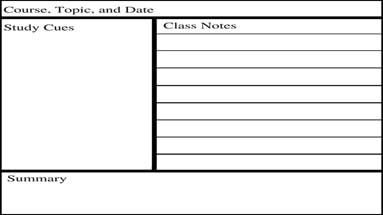
What is the Cornell Note-Taking System and How to Improve Your Note-Taking?

The Cornell note-taking system is a powerful method of organizing your notes for effective reading later Learn how to master the system with these five steps: Record, Reduce, Recite, Reflect, and Review Discover the advantages and disadvantages of using this system to improve your note-taking skills today
The Cornell note-taking system is designed to help students take organized and clear notes that can be easily referenced and understood later on. With clear instructions, this method allows students to record information efficiently and effectively, maximizing their learning experiences and retention of information.
Meaning of the Cornell notes system
The Cornell Note-taking System, also referred to as the Cornell Way, Cornell Method, or Cornell Notes System, was developed by Dr. Walter Pauk, an education professor at Cornell University in the 1940s.
How to master the Cornell note-taking system?
In his best-selling book "How to Study in College," he provides a thorough explanation of how to utilize this system effectively. The primary objective of the book is to aid students in achieving their goals by ensuring that the notes they take during lectures are meaningful and useful for future studying purposes.
The Cornell note-taking method is a great tool for those who learn visually, as it provides a structured approach to organizing ideas. It covers all aspects of note-taking and offers designated areas for note-taking, study cues, and summarizing information. Additionally, the system includes designated spaces for recording the course name, topic, and lesson date to ensure everything is kept in order.
The page layout of the Cornell note-taking template looks like this.
Use color markers to divide your page into two columns: a smaller column that occupies about 30% of the space and a larger column that occupies about 70%. Additionally, include a section at the top and another at the bottom with five to seven lines. These simple adjustments can help you create an efficient and effective Cornell notes system.
1. Record
To effectively use the Cornell notes system, it is essential to start by recording the most crucial information. The larger column is dedicated to all the notes, providing ample space to jot down everything relevant. Meanwhile, the smaller column on the left side is reserved for writing questions about the notes, which can come in handy during revision, along with critical comments and keywords for easy reference.
In order to streamline the reviewing process and avoid wasting valuable time during exam preparations, it is recommended to use the designated section at the top of the page to write the name, topic, and date. Additionally, it is crucial to ensure legible and neat handwriting, even if it requires a few extra seconds of effort. This will prevent the need to decipher notes during exams when time constraints are particularly pressing.
Do not use complete sentences as you will not be able to include all the information on the page
Take the help of shorthand and devise a system beforehand so that you recognize what you have written
Make sure to leave a space between the lines as a precautionary method as you might have to add important information later on
2. Reduce
Review your class notes and take the time to decipher any messy or unclear writing. With the information still fresh in your mind, highlight the key points and jot them down as study cues in the left-hand column next to their corresponding information. To solidify your understanding, succinctly summarize the material in your own words in the end section of your page. This will help you recall the relationships between the ideas at a later time.
3. Recite
It is crucial to dedicate sufficient time and effort to this step because you will encounter it in your exams. Maximize its usefulness by carefully examining the cues provided to ensure that you gather all the necessary information.
For auditory learners, it can be beneficial to verbally repeat the main points listed in study materials. By focusing on the cues rather than detailed notes, you can better recall and understand the information presented in class. Double-check your notes afterwards to ensure accuracy. Speaking the information aloud aids in retention and comprehension for oral learners.
4. Reflect
To truly retain information, it is essential to reflect on what you have heard and learned. Simply summarizing your notes will not suffice. Take the time to process and internalize the information, and consider how it fits into your overall understanding of the topic. This will ensure that the knowledge stays with you long-term.
5. Review
To truly engage with the information at hand, it is important to not just passively absorb it, but to actively include your thoughts and interpretations. By asking relevant questions and reflecting on how the information relates to your personal experiences or beliefs, you can establish a more meaningful connection with the material. This not only helps with retention and understanding, but also fosters a deeper appreciation for the knowledge being presented.
Reviewing your notes regularly throughout the semester can alleviate the stress of cramming for exams. By consistently revisiting the information, you are better able to retain it and apply it effectively.
Advantages
The benefits of Cornell notes are as follows-
It helps to keep the notes organized
The efficient page layout proves a time-saving process
Crates efficient and structured study sheets
There is no need for recopying
The systematic approach makes reviewing easy
Disadvantages
The disadvantages of the Cornell notes system are as follows-
Without attentive listening and note-taking during lectures, a student will struggle to keep accurate records of the material. However, maintaining these notes also requires consistent review, a task that many students find difficult to prioritize due to time constraints or lack of motivation.
Conclusion
Cornell notes pdf is a systematic approach that has proved a blessing for the students who previously found note-taking a stressful undertaking.
This incredibly powerful tool helps to absorb and retain information at a faster pace and has made the journey of revisiting the content smooth and easy.








